Do you want to make your chest workout more challenging and better? Then, you should not look further than cable chest exercises.
Cable chest exercises are an effective way to strengthen your chest muscles, with constant tension throughout the movement and a full range of motion.
As we all know, a well-shaped chest is one of the most important qualities of a good physique.
To achieve this, you need to train your chest with a variety of exercises to build the upper pec and lower pec, the inside and outside pectorals, and the entire rib cage.
The cable chest exercises are designed to provide a complete workout by training the chest muscles from various angles.
In this blog, we’ll blog we will discuss the following topics:
- Chest Anatomy
- Best Cable Chest Exercises
- How to do it, and pro-tips.
- Training Plan As Per Your Goal
- Workout Samples For Beginner, Intermediate & Advance
- Benefits of the Cable Chest Exercises
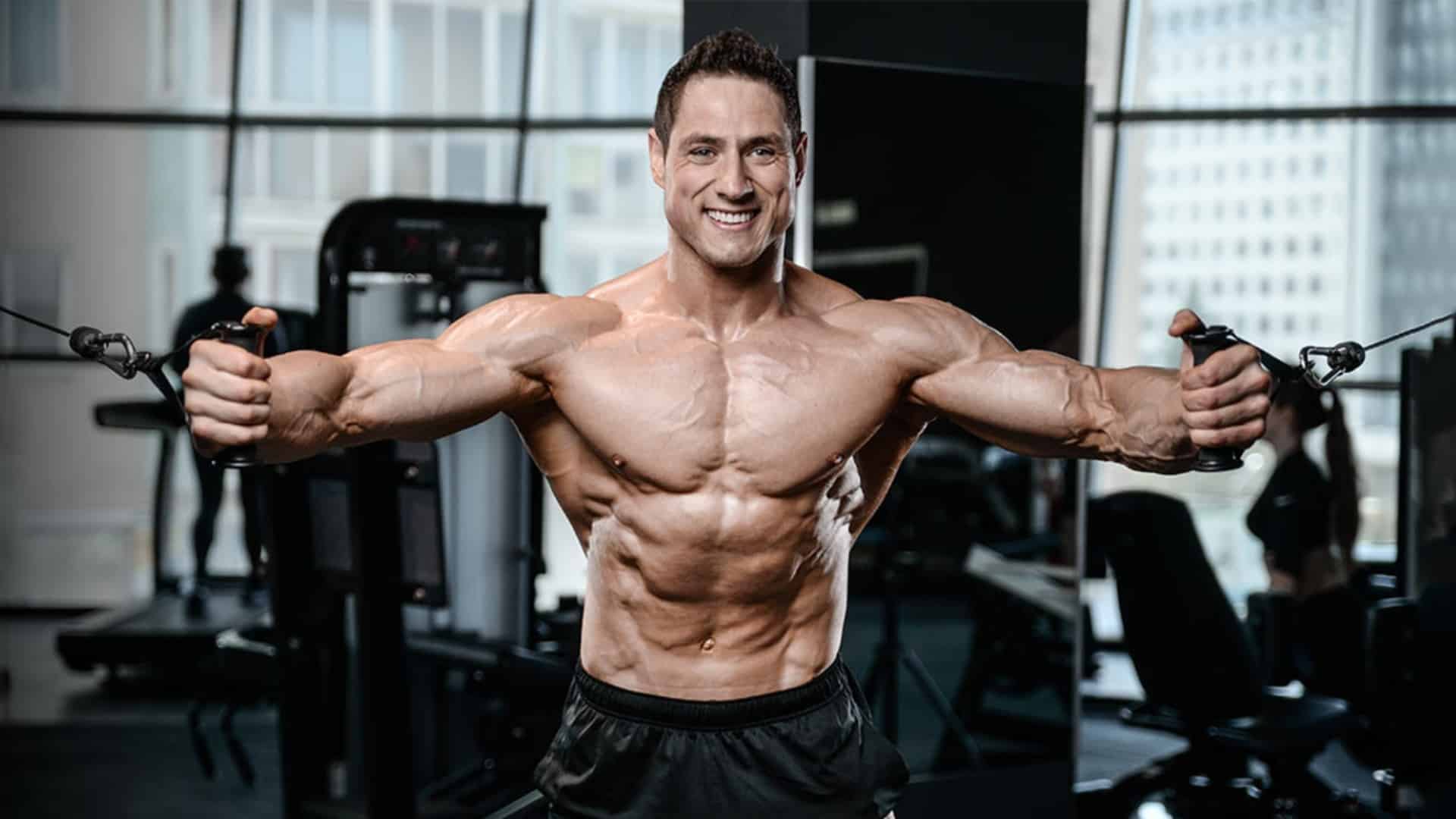
- Know More About Chest Muscles
- What is Cable Chest Workout
- Types of Chest Cable Exercises
- How to Build the Chest With Cable Machine
- 14 Best Cable Chest Exercises To Build Mass and Strength
- 1. Cable Crossover (Middle Cable Fly)
- How To Do
- Tip For Proper Form
- 2. Low Cable Fly (Low to High Cable Fly)
- How To Do
- Tip For Proper Form
- 3. High Cable Fly (High to Low Cable Fly)
- How To Do
- Tip For Proper Form
- 4. Standing Cable Chest Press
- How To Do
- Tip For Proper Form
- 5. Cable Flat Bench Press
- How To Do
- Tip For Proper Form
- 6. Cable Incline Bench Press
- How To Do
- Tip For Proper Form
- 7. Cable Decline Bench Press
- How To Do
- Tip For Proper Form
- 8. Lying Cable Chest Fly
- How To Do
- Tip For Proper Form
- 9. Incline Cable Fly
- How To Do
- Tip For Proper Form
- 10. Cable Press On Stability Ball
- How To Do
- Tip For Proper Form
- 11. Cable Incline Fly On Stability Ball
- How To Do
- Tip For Proper Form
- 12. Decline Cable Fly
- How To Do
- Tip For Proper Form
- 13. Single Arm Chest Fly
- How To Do
- Tip For Proper Form
- 14. Cable Pullover
- How To Do
- Tip For Proper Form
- Cable Chest Workout Training Plan
- Training Volume (Sets and Reps)
- Training Plan As Per Your Goal
- Workout Samples For Beginner, Intermediate & Advance
- Cable Chest Workout Routine For Beginner
- Workout Routine For Intermediate
- Cable Chest Workout Routine For Advance
- Benefits of the Cable Chest Exercises
- 1. Joint Friendly
- 2. Provide Constant Tension
- 3. Increased range of motion
- 4. Smooth and Controlled Motion
- 5. Targeted muscle activation
- 6. Versatility
- 7. Boast Muscle Growth
- Note:
- FAQ
- Should I perform cable chest exercises at the beginning or end of my workout?
- Can cable chest exercises replace traditional chest exercises?
- Can cable chest exercises be performed at home?
- Conclusion
- References
- Best Cable Chest Workout To Build Massive Chest
Know More About Chest Muscles
The muscles of the chest consist of the pectoralis major and the pectoralis minor.
The pectoralis major itself comprises two heads, each of which may be worked differently depending on the angle of adduction:
- An upward angle of movement emphasizes the upper pec or clavicular head,
- While a lower angle emphasizes the lower pec, or sternal head, of the muscle.
The pectoralis minor is the triangle-shaped muscle located under the pectoralis major, a layer deeper, and draws the shoulder blades down and forward.
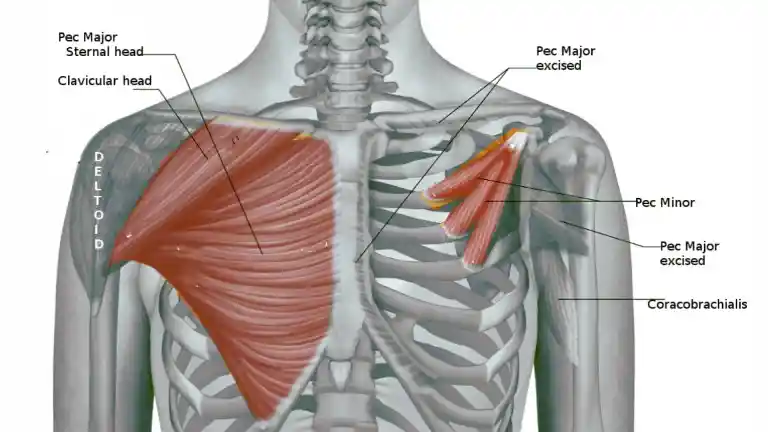
What is Cable Chest Workout
The cable chest exercises are strength-building exercises that employ a cable machine to strengthen the chest muscles.
It uses a cable pulley system to create constant tension on the chest muscles throughout the entire range of motion. This tension can help to build strength, size, and definition in the chest muscles.
Chest exercises using cables will provide smooth constant tension on your muscles, which leads to more time under tension and in turn more potential for muscle growth.
From a standing, sitting, or lying position, you can do all the variations of free weight chest presses and flys with a cable machine, plus more.
Types of Chest Cable Exercises
There are several types of chest exercises that can be performed using a cable machine.
- Cable Flyes
- Cable Crossovers
- Cable Chest Press
- Pullovers
Each exercise can be adjusted to meet your requirements and provides constant tension on the chest muscles throughout the entire range of motion.
- Press exercises are multijoint exercises, which primarily focus on the chest muscle but also train the deltoid and the tricep.
- Cable Flyes targets the chest muscles from a different angle than traditional flyes. This exercise can be performed with both arms simultaneously or one arm at a time to further isolate the chest muscles.
- Cable Crossovers are like a flyes, but the cables are crossed over each other in front of the body. You can do this exercise in different ways, like standing, kneeling, or with just one arm at a time.
How to Build the Chest With Cable Machine
Cable exercises for the chest are a great way to build and strengthen your pectoralis major, which is the main muscle in your chest.
Using the cable machine, you’ll be able to hit all pecs muscles from different angles and through a range of motions.
You can also change body positioning, weight load and attachments used, which can alter your grip, thus targeting your muscles differently.
How to do the best chest workout on a cable machine to get stronger and bigger, how many times you do each exercise depends on how fit you are, how many times you do it each week, and what you want to achieve with your training. Mass, strength and endurance
For strength gains, do 4 to 6 sets of 1 to 6 reps each exercise with a weight that is at least 85% of your one-repetition maximum (1RM) The fewer reps you perform, the closer to 100% of your 1RM you should strive for.
If your goal is hypertrophy (muscle growth), perform three sets of each exercise, using loads that are 70 to 85% of your 1RM for 8 to 12 reps.
When training for endurance, it is usually recommended to use higher reps (15 to 20 repetitions) and moderate loads, with a weight that is at least 50 to 70% of your 1RM.
14 Best Cable Chest Exercises To Build Mass and Strength
The two main chest exercises you are going to do with cables are presses and flys. However, there are many variations for both cable presses and cable flys.
Here are the Best cable chest exercises that help to build a bigger and wider Chests. These exercises will hit your pecs from all the angles.
Cable chest workout provided the highest activation, and together they will allow you to do press and flys that target each and every muscle fiber in your chest.
- Cable Crossover (Middle Cable Fly)
- Low Cable Fly (Low to High Cable Fly)
- High Cable Fly (High to Low Cable Fly)
- Standing Cable Chest Press
- Cable Flat Bench Press
- Cable Incline Bench Press
- Cable Decline Bench Press
- Lying Cable Chest Fly
- Incline Cable Fly
- Cable Press On Stability Ball
- Cable Incline Fly On Stability Ball
- Decline Cable Fly
- Single Arm Chest Fly
- Cable Pullover
1. Cable Crossover (Middle Cable Fly)
If you’re looking for straightforward cable machine chest exercises to add to your routine, cable crossover are a great staple exercise to get you started. It provides constant tension in helping build massive pecs.
Standing cable crossover Exercise helps to develop and define the lower and the Inner pectoral muscles.
Cable provides constant resistance and helps develop the lower and the central chest muscles by providing the much-needed stress in the lower and the inner pecs.

How To Do
- In a standing position, grab and hold the handles of overhead pulleys on both sides.
- Bend slightly forwards and extend your arms, feeling a good stretch in your chest muscles.
- Now flex your arms with elbows slightly bent and get a good chest contraction.
- Unlike chest flies, you can cross over the center to get full Pec contraction.
Tip For Proper Form
- Breathe in on the relaxation phase and breathe out when contracting, keeping your head up at all times.
- Squeeze your chest at the end of the movement.
Related Post Lower Chest Cable Exercises for Bigger & Stronger Chest
2. Low Cable Fly (Low to High Cable Fly)
The standing low to high cable fly is a variation of the chest fly and a cable exercise used to strengthen the pushing muscles of the body including the chest, biceps, and shoulders. It provides constant tension, helping build upper pecs.
Low to High Cable Fly exercise helps to develop and define upper and inner pectoral muscles.

How To Do
- Set both pulleys as low as possible and select the desired weight.
- In a standing position, grab and hold the handles of overhead pulleys on both sides.
- Bend slightly forwards, and extend your arms, feeling a good stretch in your chest muscles.
- Bend your elbows slightly, pull your hands toward each other in wide arcs in front of you, pausing when your hands touch.
- Slowly lower back to the starting position and repeat for the desired number of repetitions.
Tip For Proper Form
- To keep your balance, stand in a staggered stance.
- Breathe out as you lift the handles up and together.
- Control the weight as you bring your arms back down.
Know More: Upper Chest Cable Exercises For Bigger & Stronger Chest
3. High Cable Fly (High to Low Cable Fly)
The high to low cable fly is a variation of the chest fly, and it is a great exercise to target the lower portion of your chest.
High to low cable fly is a machine exercise that primarily targets the chest and to a lesser degree also targets the shoulders and triceps.

How To Do
- Set both pulleys as High as possible and select the desired weight.
- In a standing position, take a neutral grip on the handles.
- Bend slightly forwards, and extend your arms, feeling a good stretch in your chest muscles.
- Bend your elbows slightly, pull your hands (high to low) toward each other in wide arcs in front of you, pausing when your hands touch.
- Slowly lower back to the starting position and repeat for the desired number of repetitions.
Tip For Proper Form
- Ensure you maintain some tension in your abs and don’t allow your lower back to arch excessively.
- Focus on form before choosing a heavy weight.
- Breathe out as you pull the handles together.
Read More: Lower Chest Cable Exercises For Bigger & Stronger Chest
4. Standing Cable Chest Press
The Standing cable chest press is the another great exercise for your cable chest workout, it can increase the range of motion to where your hands meet as compared to the convention bench press.
The standing bench press engages your core and stabilizer muscles far more, as you are having to control every angle that the weight can potentially move in.
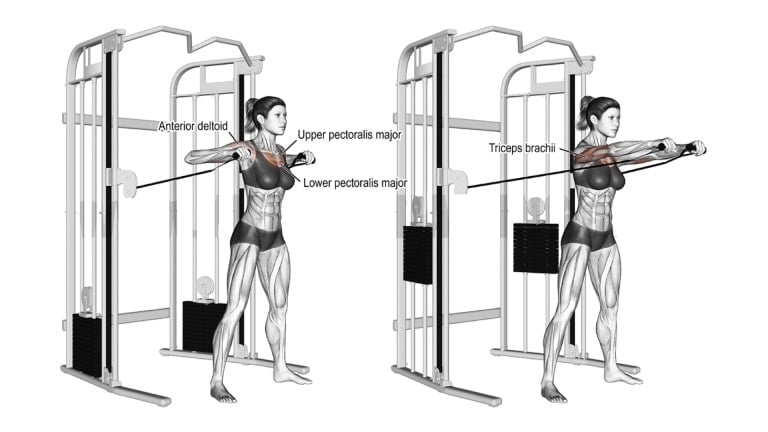
How To Do
- Stand in the center of the two pulleys and grip the stirrups on both side.
- Step forward a couple of foot in front of the cable machine with one leg in front of the other to form a staggered stance or as comfortable for you.
- Move the handles forward through, extending via your elbows, until your hands meet in the center.
- Briefly squeeze before slowly bring back to the starting position.
Tip For Proper Form
- Ensure your head is up, your core is engaged, and the rest of your body is stable and stationary.
- Breathe in on the relaxation phase and breathe out when contracting, keeping your head up at all times.
- Squeeze your chest at the end of the movement.
5. Cable Flat Bench Press
Lying Cable chest Press allows for a user to perform a flat bench press without the need for a spotter.
The level of constant tension involved with cable chest presses is much greater than most traditional free-weight chest presses, simply because the strength curve of the cable pulleys more closely matches that of the movement/muscles.
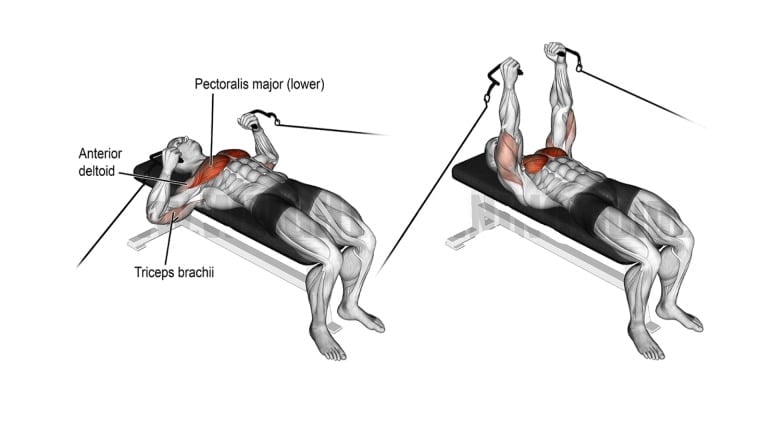
How To Do
- Attach stirrup handles to the low pulleys. Lie on the bench with your feet flat on the floor.
- Lift your arms straight up from your shoulders and hold the cable directly over your middle chest.
- Slowly lower the cable attachments outward to your sides, remember to keep your arms slightly bent until your arms are parallel with the ground horizontally,
- Bring your arms back toward the mid-line of your body, focusing on using your pecs muscles to draw them back together. Repeat as many repetitions as are desired.
Tip For Proper Form
- Do not overstretch during the negative phase of the exercise.
- Hold and contract the chest muscles when hands are together.
- Always keep your arms bent to protect the shoulder joint.
6. Cable Incline Bench Press
During dumbbell incline bench presses, the resistance is directly downward, and your triceps brachii take over much of the force from your chest at the top of the press.
In contrast, the incline cable bench press maintains more focus on your upper pectoralis major throughout the movement because the resistance originates from an angle, and you have to push the stirrups upward and pull them inward at the top of the movement.
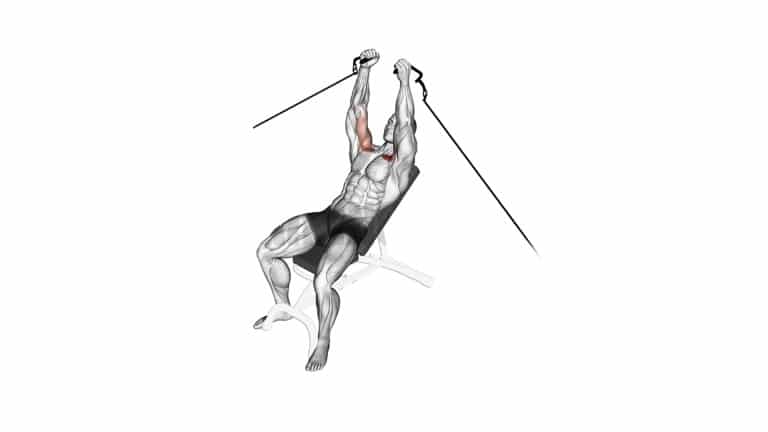
How To Do
- Set an incline bench at a 30-to 45-degree angle.
- Attach stirrup handles to the low pulleys and lie down on the bench with your feet flat on the floor.
- Exhale as you extend your elbows up to move your arms up and inwards until your hand meet.
- Squeeze your chest at the top of the movement and then inhale as you slowly release back to the starting position.
- Repeat as many repetitions as are desired.
Tip For Proper Form
- Vary the position of the bench to hit different angles of the upper chest.
- Hold and contract the chest muscles when hands are together.
- Set the bench at about 30–45 degrees inclined. Do not go more upright as the stress shifts more to the shoulders rather than the chest area.
7. Cable Decline Bench Press
The decline cable chest press is a variation of the decline dumbbell bench press.
The Decline cable press is a great compound exercise for your chest, shoulders, and triceps.
Using cables, as seen in the decline cable chest press, allows one to keep constant tension on the target muscle groups throughout the exercise.
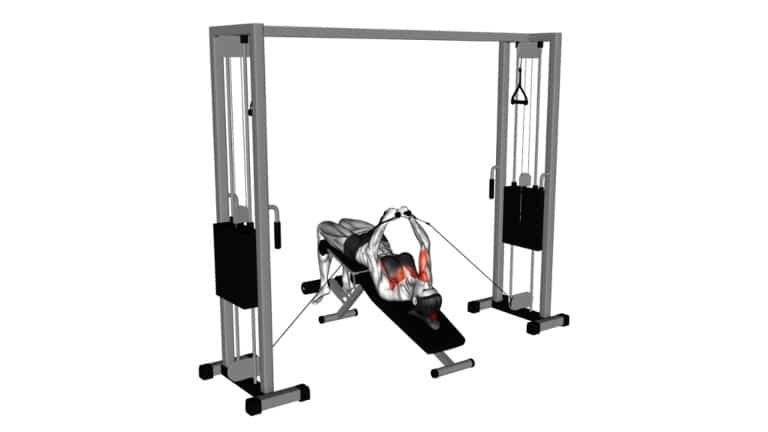
How To Do
- Set a Decline bench at a 30-degree angle. Lie on the bench with your feet flat on the foot pad or the roller.
- Lift your arms straight up from your shoulders and hold the cable handle directly over your chest.
- Once in position, slowly press and extend your arms straight out until you feel tension in your chest, and hold for a count.
- Bring your arms back toward the mid-line of your body, focusing on using your lower pecs muscles to draw them back together.
Tip For Proper Form
- Maintain more tension through the pecs by not locking out the elbows entirely.
- Vary the position of the bench to hit different angles of the lower chest.
- Hold and contract the chest muscles when hands are together.
- Set bench at about 30 degrees Decline.
8. Lying Cable Chest Fly
The lying cable fly is an isolation exercise that builds muscle and strength in the Pectoralis Major (Chest).
Cables are a great tool for allowing you to keep tension on the chest muscle, and they are especially effective when training the chest.

How To Do
- Attach stirrup handles to the low pulleys. Lie on the bench with your feet flat on the floor.
- Lift your arms straight up from your shoulders and hold the cable directly over your middle chest.
- Slowly lower the cable attachments outward to your sides, remember to keep your arms slightly bent until your arms are parallel with the ground horizontally,
- Bring your arms back toward the mid-line of your body, focusing on using your pecs muscles to draw them back together. Repeat as many repetitions as are desired.
Tip For Proper Form
- Do not overstretch during the negative phase of the exercise.
- Hold and contract the chest muscles when hands are together.
- Always keep your arms bent to protect the shoulder joint.
Know More: Cable Fly: Muscle Worked, Alternate, Variations
9. Incline Cable Fly
The incline cable fly is an isolation exercise that primarily targets the upper chest muscles.
It is performed using a cable machine with an adjustable pulley system and a bench set at an incline angle of around 30–45 degrees.
Performing this exercise with cables instead of dumbbells allows for constant tension, which helps build Upper Chest fibers.

How To Do
- Set an incline bench at a 30-to 45-degree angle.
- Attach stirrup handles to the low pulleys and lie down on the bench with your feet flat on the floor.
- Lift your arms straight up from your shoulders and hold the cable directly over your upper chest.
- Slowly lower the cable attachments outward to your sides, remember to keep your arms slightly bent until your arms are parallel with the ground horizontally
- Bring your arms back toward the midline of your body, focusing on using your pec muscles to draw them back together.
Tip For Proper Form
- Keep your core engaged and your back flat against the bench throughout the movement.
- Use a weight that challenges you but allows you to maintain proper form.
- Exhale as you bring the handles together, and inhale as you lower them back down.
- Vary the position of the bench to hit different angles of the upper chest.
10. Cable Press On Stability Ball
Cable press on a stability ball is the best exercise that strengthens both your chest and core muscles.
It also increases hip and glute activation and total body stability, while increasing muscle activation of the pectorals and hips.
This movement can be done with heavy or light loads to increase triceps, chest, and core strength in the press.

How To Do
- Start off by sitting on an exercise ball, gripping cable handles in each hand.
- Slowly walk your feet out in front of you so that your legs are extended out in front of you with knees bent and your back is flat in the middle of the ball.
- Move the handles forward through, extending via your elbows, until your hands meet in the center.
- Hold on to this position for a few seconds, then returning back down to the starting position. Repeat for as many reps and sets as desired.
Tip For Proper Form
- Perform the exercise properly and make sure they don’t lose their balance and fall.
- Keep your head and spine in a neutral position, raise the hips, tighten your core.
- Do the exercise slowly and do not use momentum.
11. Cable Incline Fly On Stability Ball
If you’re looking for a way to get more creative with your cable chest workout, why not try cable Incline Fly On a Stability Ball? This exercise might look simple since you’re lying back on the ball, but there’s still a lot going on when you’re performing it.
Cable Incline Fly can be performed by lying on the stability ball with cable handles in your both hands. This is a difficult exercise but extremely important.
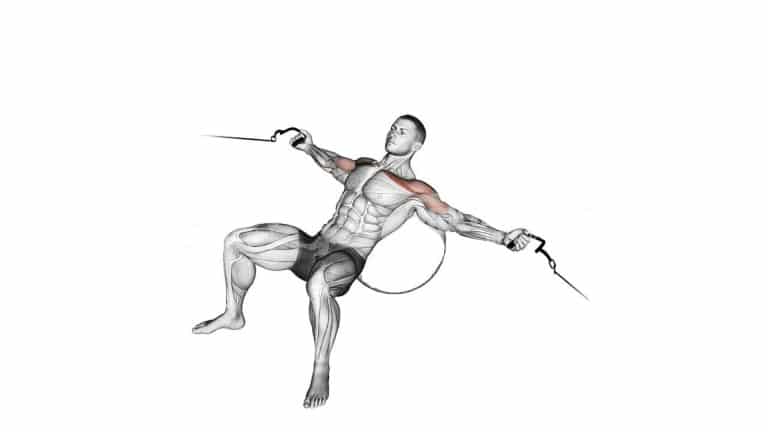
How To Do
- Start off by sitting on an exercise ball, gripping cable handles in each hand.
- Slowly roll down on the exercise ball, making sure that your head and neck are on the ball with your feet planted on the floor ahead of you.
- Lift up with the cables and bring them straight up above your chest, squeezing throughout the entire motion.
- Hold on to this position for a few seconds, then returreturnning back down to the starting position. Repeat for as many reps and sets as desired.
Tip For Proper Form
- Perform the exercise properly and make sure they don’t lose their balance and fall.
- Do the exercise slowly and do not use momentum.
12. Decline Cable Fly
Finally, if you’re looking for one more effective cable chest exercise to train your lower chests, try the decline cable fly.
It is one of the most suitable exercises for isolating the lower chest muscles.
Adding decline cable fly variations to your workout routine can help to target lower chest muscles, and add variety to your workouts.

How To Do
- Set a Decline bench at a 30-degree angle. Lie on the bench with your feet flat on the footpad or the roller.
- Lift your arms straight up from your shoulders and hold the cable handle directly over your chest.
- Slowly lower your arms out to your sides until your wrists come to about shoulder level or slightly above.
- Bring your arms back toward the midline of your body, focusing on using your lower pec muscles to draw them back together.
Tip For Proper Form
- Don’t let your elbows drop too far when you’re in the start position, they should remain in line with your torso.
- Pick a weight that you can control, that’s not too light or too heavy — find what’s right for you.
- Hold and contract the chest muscles when hands are together.
Read More To Know More: Decline Fly: Muscle Worked, Benefits, Form
13. Single Arm Chest Fly
When doing a chest workout with a cable machine, there are plenty of single-arm exercises you can add to correct potential imbalances.
The one-arm fly is a unilateral variation of the fly. It is used by those who would like to focus on the inner side.
During Exercise, emphasis is placed on bringing the resistance further across the body and past the midline, thus extending the range of motion to force an intense peak contraction in the inner pec.

How To Do
- Begin by moving the pulleys to the high position, select the resistance to be used, and take a handle in one hand.
- Extend your arm and make sure to have a slight bend in your elbow.
- Slowly, pull your hand to the midline of your chest while keeping your upper body straight.
- Hold for a second, and go back to the starting position to complete one rep.
Tip For Proper Form
- Always keep the elbows slightly bent for full inner pec activation.
- Ensure to keep your core engaged throughout the movement and breathe
- Keep a controlled motion and avoid jerky movements.
14. Cable Pullover
The lying cable pullover is a great alternative to the barbell pullover or dumbbell pullover.
Cable Pullover is the best exercise to build a strong rib cage and build serratus anterior muscle to build a complete chest and back. Pullover work directly on the serratus anterior muscle to develop the back.

How To Do
- Set up the bench in front of a low pulley cable machine and leave about 2–3 feet between the bench and the machine.
- Lay down on the bench on your back with your head up near the end closest to the cable machine. Grasp a rope with both hands.
- Keeping your arms straight and slowly pull your hands up and across the top of your head.
- Pause, and then lower the weight back to the starting position. Repeat for desired reps.
Tip For Proper Form
- Maximum stretching ensures the greatest expansion of the rib cage.
- Do the exercise slowly and do not use momentum.
Cable Chest Workout Training Plan
When doing chest exercises using cables, it is important to remember that, exercises should target both your upper and lower portions of your chest. This will help give your arms the shape and definition you’re looking for— in addition to providing you strength.
The Cable chest exercises listed will be performed with moderate loads and repetitions to emphasize both muscular hypertrophy (muscle growth) and muscular endurance. Load and volume (sets, reps) can be increased as your fitness and strength improve
Training Volume (Sets and Reps)
Of course, the number of sets and reps will be determined based on your fitness journey, but here is a great starting point:
Sets
- Beginners: ~10 sets per week.
- Intermediate: ~15 sets per week.
- Advanced: ~20 sets per week.
When a certain amount of volume stops being effective and your progress stalls, you can add sets to increase volume and use that as a driver of renewed progress.
Reps
The best rep ranges and loads to work with.
- 6-8 reps with heavy load
- 8-15 reps with moderate load
- 15-20+ with light load
The load should bring you to or near failure within the given rep ranges to be effective.
Training Plan As Per Your Goal
- For muscle endurance: Aim for 3-4 sets of 12-15 reps, with a moderate amount of resistance.
- For muscle strength: Aim for 3-5 sets of 6-10 reps, with a heavier amount of resistance.
- For muscle hypertrophy (increased muscle size): Aim for 3-4 sets of 8-12 reps, with a moderate to heavy amount of resistance.
It is always best to start with a lower number of reps and sets, and then gradually increase as your strength improves.
Furthermore, it is important to allow for adequate rest between sets, typically 60-90 seconds.
Incorporating a mix of bodyweight exercises, cardio, and weight training can help to achieve a balanced and well-rounded workout routine.
Workout Samples For Beginner, Intermediate & Advance
This workout contains multiple cable exercises that are designed to target all the muscles in your chest and increase overall muscle mass.
This workout plan is a starting point that can be adjusted based on individual fitness levels and goals.
It will be important to perform each set to muscular fatigue. In other words, the last few repetitions should be difficult to perform, but you should be able to keep ideal form, posture, and technique throughout the entire set.
Cable Chest Workout Routine For Beginner
| Exercise | Sets | Reps | Rest |
|---|---|---|---|
| Standing Cable Chest Press | 3-4 | 8-10 | 60-90 seconds |
| Cable Incline Bench Press | 3-4 | 8 | 60-90 seconds |
| Crossover | 4 | 8-10 | 60-90 seconds |
Workout Routine For Intermediate
| Exercise | Sets | Reps | Rest |
|---|---|---|---|
| Flat Cable Bench Press | 4 | 8-10 | 45-60 seconds |
| Low Cable Fly | 3-4 | 10-12 | 45-60 seconds |
| Cable Pullover | 4 | 8-10 | 45-60 seconds |
| Cable Crossovers | 3 | 10-12 | 45-60 seconds |
Cable Chest Workout Routine For Advance
Here’s a sample cable only workout plan for advanced:
| Exercise | Sets | Reps | Rest |
|---|---|---|---|
| Cable Chest Press | 3-4 | 10-12 | 30-45 seconds |
| Low-to-High Cable Flyes | 3-4 | 10-12 | 30-45 seconds |
| High-to-Low Cable Flyes | 3-4 | 8-10 | 30-45 seconds |
| Cable Crossovers | 3 | 10-12 | 30-45 seconds |
| Single-Arm Cable Chest Press | 3 | 12-15 | 30-45 seconds |
Benefits of the Cable Chest Exercises
Here are the main benefits of using cables for chest work:
1. Joint Friendly
For people who experience discomfort in their joints during the bench press, cable chest exercises are a great alternative.
With proper shoulder-blade stability, the cable changes the angle of the movement enough to limit the potential stress on the joints.
2. Provide Constant Tension
Cable exercises are more evenly distributed, and you have more of a constant load on your chest muscles throughout the whole range of motion due to which cable exercises better than free weights.
3. Increased range of motion
Cable chest exercises allow for a greater range of motion than traditional chest exercises, helping to improve flexibility and mobility in the chest muscles.
4. Smooth and Controlled Motion
The cable machine workout offers a smooth, controlled motion that can be manipulated by the variables above to deliver the exact resistance you’re looking for.
5. Targeted muscle activation
Varying the position of the body and the direction of cable, you can work out various parts of the pectoral muscles.
Including the upper, middle, and lower chest, helping to create a more balanced and defined chest.
6. Versatility
Cable chest exercises can be easily modified by adjusting the weight, the angle of the pulleys, and the attachments used, making them a versatile and effective addition to any workout routine.
7. Boast Muscle Growth
The cable setup gives your muscles almost uninterrupted time under tension, and a huge pump — each of which can help optimize muscle growth.
Note:
It’s a good idea to add a variety of exercises to your chest workout routine to target the muscle from different angles and provide overall muscle growth.
Be smart: don’t limit yourself to cable chest exercises. Get the benefits they offer and use other chest exercises to supplement them when needed.
Cable workout can be easily incorporated into any training program and can be particularly effective when used alongside dumbbells, barbells, machines, and bodyweight to build the biggest, strongest arm possible.
FAQ
Should I perform cable chest exercises at the beginning or end of my workout?
The cable chest exercises can be performed at the beginning or end of your workout, depending on your goals.
If you want to focus on chest training, consider doing cable chest exercises at the beginning of your workout.
Can cable chest exercises replace traditional chest exercises?
Cable chest exercises are a good addition to your workout routine, but they shouldn’t replace traditional chest exercises completely.
Try to include different exercises to target different areas of the chest muscles and create a well-rounded workout routine.
Can cable chest exercises be performed at home?
Yes, cable chest exercises can be done at home if you have a cable machine or resistance bands.
There are also many chest exercises that can be performed without any equipment, such as push-ups and chest dips.
Conclusion
Doing the chest workout using cable machine exercises, will give your chest a complete workout, focusing on equal parts on each section of your pectorals for improved performance and aesthetics.
For anyone interested in building body strength and gaining muscle, this Best cable Chest Exercise and Workout plan is highly recommended.
Let us know, in the comment section below, your favorite cable chest exercises!
Thanks for reading!
References
- Damas F., Libardi C.A., Ugrinowitsch C. The development of skeletal muscle hypertrophy through resistance training: The role of muscle damage and muscle protein synthesis. Eur. J. Appl. Physiol. 2018;118:485–500. doi: 10.1007/s00421-017-3792-9.
- Ralston G.W., Kilgore L., Wyatt F.B., Buchan D., Baker J.S. Weekly Training Frequency Effects on Strength Gain: A Meta-Analysis. Sports Med. Open. 2018;4:36. doi: 10.1186/s40798-018-0149-9.
- Schoenfeld B.J., Ogborn D., Krieger J.W. Dose-response relationship between weekly resistance training volume and increases in muscle mass: A systematic review and meta-analysis. J. Sports Sci. 2017;35:1073–1082. doi: 10.1080/02640414.2016.1210197.
- Counts B.R., Buckner S.L., Mouser J.G., Dankel S.J., Jessee M.B., Mattocks K.T., Loenneke J.P. Muscle growth: To infinity and beyond?: Muscle Hypertrophy Time Course. Muscle Nerve. 2017;56:1022–1030. doi: 10.1002/mus.25696.
Best Cable Chest Workout To Build Massive Chest

Manish brings over 10 years of hands-on experience in weight lifting and fat loss to fitness coaching. He specializes in gym-based training and has a lot of knowledge about exercise, lifting technique, biomechanics, and more.
Through “Fit Life Regime,” he generously shares the insights he’s gained over a decade in the field. His goal is to equip others with the knowledge to start their own fitness journey.

I found the article very informative. Keep posting such articles on health and fitness. It really motivates people like me.